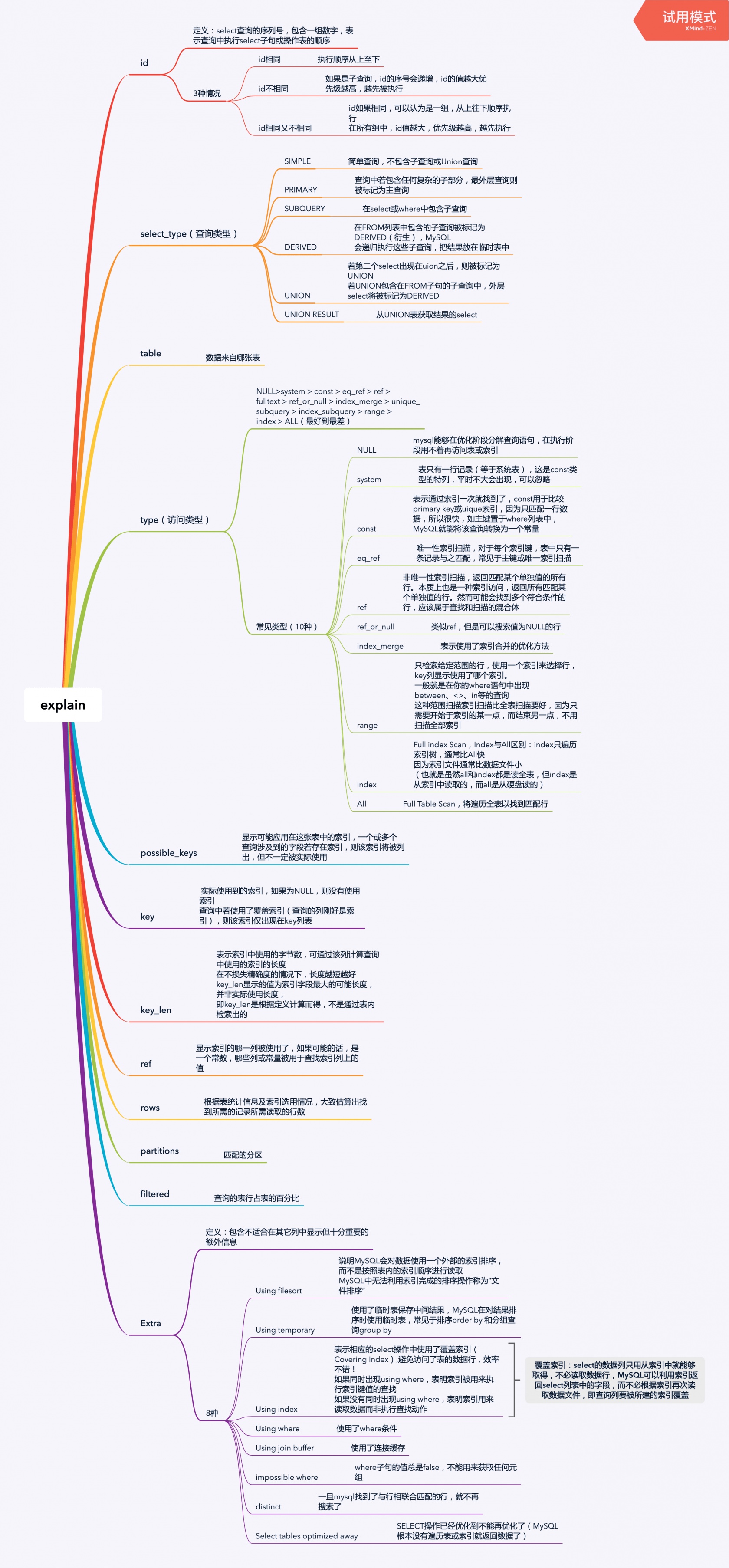转自:https://www.toutiao.com/i6776461352522220036/?tt_from=weixin&utm_campaign=client_share&wxshare_count=1×tamp=1597162174&app=news_article&utm_source=weixin&utm_medium=toutiao_ios&use_new_style=1&req_id=20200812000933010018086069053B6937&group_id=6776461352522220036
refer:https://www.cnblogs.com/yycc/p/7338894.html
explain的用途
1. 表的读取顺序如何
2. 数据读取操作有哪些操作类型
3. 哪些索引可以使用
4. 哪些索引被实际使用
5. 表之间是如何引用
6. 每张表有多少行被优化器查询
......explain的执行效果
mysql> explain select * from subject where id = 1 G
******************************************************
id: 1
select_type: SIMPLE
table: subject
partitions: NULL
type: const
possible_keys: PRIMARY
key: PRIMARY
key_len: 4
ref: const
rows: 1
filtered: 100.00
Extra: NULL
******************************************************explain包含的字段
1. id //select查询的序列号,包含一组数字,表示查询中执行select子句或操作表的顺序
2. select_type //查询类型
3. table //正在访问哪个表
4. partitions //匹配的分区
5. type //访问的类型
6. possible_keys //显示可能应用在这张表中的索引,一个或多个,但不一定实际使用到
7. key //实际使用到的索引,如果为NULL,则没有使用索引
8. key_len //表示索引中使用的字节数,可通过该列计算查询中使用的索引的长度
9. ref //显示索引的哪一列被使用了,如果可能的话,是一个常数,哪些列或常量被用于查找索引列上的值
10. rows //根据表统计信息及索引选用情况,大致估算出找到所需的记录所需读取的行数11. filtered //查询的表行占表的百分比12. Extra //包含不适合在其它列中显示但十分重要的额外信息图片版

文字版
id字段
1. id相同
执行顺序从上至下
例子:explain select subject.* from subject,student_score,teacher where subject.id = student_id and subject.teacher_id = teacher.id;
读取顺序:subject > teacher > student_score
2. id不同
如果是子查询,id的序号会递增,id的值越大优先级越高,越先被执行
例子:explain select score.* from student_score as score where subject_id = (select id from subject where teacher_id = (select id from teacher where id = 2));读取顺序:teacher > subject > student_score
3. id相同又不同
id如果相同,可以认为是一组,从上往下顺序执行在所有组中,id值越大,优先级越高,越先执行
例子:explain select subject.* from subject left join teacher on subject.teacher_id = teacher.id -> union -> select subject.* from subject right join teacher on subject.teacher_id = teacher.id; 读取顺序:2.teacher > 2.subject > 1.subject > 1.teacher
select_type字段
1. SIMPLE
简单查询,不包含子查询或Union查询
例子:explain select subject.* from subject,student_score,teacher where subject.id = student_id and subject.teacher_id = teacher.id;
2. PRIMARY
查询中若包含任何复杂的子部分,最外层查询则被标记为主查询
例子:explain select score.* from student_score as score where subject_id = (select id from subject where teacher_id = (select id from teacher where id = 2));
3. SUBQUERY
在select或where中包含子查询
例子:explain select score.* from student_score as score where subject_id = (select id from subject where teacher_id = (select id from teacher where id = 2));
4. DERIVED
在FROM列表中包含的子查询被标记为DERIVED(衍生),MySQL会递归执行这些子查询,把结果放在临时表中
备注:MySQL5.7+ 进行优化了,增加了derived_merge(派生合并),默认开启,可加快查询效率5. UNION
若第二个select出现在uion之后,则被标记为UNION
例子:explain select subject.* from subject left join teacher on subject.teacher_id = teacher.id -> union -> select subject.* from subject right join teacher on subject.teacher_id = teacher.id;
6. UNION RESULT
从UNION表获取结果的select
例子:explain select subject.* from subject left join teacher on subject.teacher_id = teacher.id -> union -> select subject.* from subject right join teacher on subject.teacher_id = teacher.id;
type字段
NULL>system>const>eq_ref>ref>fulltext>ref_or_null>index_merge>unique_subquery>index_subquery>range>index>ALL //最好到最差
备注:掌握以下10种常见的即可
NULL>system>const>eq_ref>ref>ref_or_null>index_merge>range>index>ALL1. NULL
MySQL能够在优化阶段分解查询语句,在执行阶段用不着再访问表或索引
例子:explain select min(id) from subject;
2. system
表只有一行记录(等于系统表),这是const类型的特列,平时不大会出现,可以忽略3. const
表示通过索引一次就找到了,const用于比较primary key或uique索引,
因为只匹配一行数据,所以很快,如主键置于where列表中,MySQL就能将该查询转换为一个常量
例子:explain select * from teacher where teacher_no = 'T2010001';
4. eq_ref
唯一性索引扫描,对于每个索引键,表中只有一条记录与之匹配,常见于主键或唯一索引扫描
例子:explain select subject.* from subject left join teacher on subject.teacher_id = teacher.id;
5. ref
非唯一性索引扫描,返回匹配某个单独值的所有行本质上也是一种索引访问,
返回所有匹配某个单独值的行然而可能会找到多个符合条件的行,应该属于查找和扫描的混合体
例子:explain select subject.* from subject,student_score,teacher where subject.id = student_id and subject.teacher_id = teacher.id;
6. refornull
类似ref,但是可以搜索值为NULL的行
例子:explain select * from teacher where name = 'wangsi' or name is null;
7. index_merge
表示使用了索引合并的优化方法
例子:explain select * from teacher where id = 1 or teacher_no = 'T2010001' .
8. range
只检索给定范围的行,使用一个索引来选择行,
key列显示使用了哪个索引一般就是在你的where语句中出现between、<>、in等的查询
例子:explain select * from subject where id between 1 and 3;
9. index
Full index Scan,Index与All区别:index只遍历索引树,
通常比All快因为索引文件通常比数据文件小,也就是虽然all和index都是读全表,
但index是从索引中读取的,而all是从硬盘读的。
例子:explain select id from subject;
10. ALL
Full Table Scan,将遍历全表以找到匹配行
例子:explain select * from subject;
table字段
数据来自哪张表possible_keys字段
显示可能应用在这张表中的索引,一个或多个查询涉及到的字段若存在索引,
则该索引将被列出,但不一定被实际使用key字段
实际使用到的索引,如果为NULL,则没有使用索引查询中若使用了覆盖索引(查询的列刚好是索引),
则该索引仅出现在key列表key_len字段
表示索引中使用的字节数,可通过该列计算查询中使用的索引的长度在不损失精确度的情况下,
长度越短越好key_len显示的值为索引字段最大的可能长度,
并非实际使用长度即key_len是根据定义计算而得,不是通过表内检索出的ref字段
显示索引的哪一列被使用了,如果可能的话,是一个常数,哪些列或常量被用于查找索引列上的值rows字段
根据表统计信息及索引选用情况,大致估算出找到所需的记录所需读取的行数partitions字段
匹配的分区filtered字段
查询的表行占表的百分比Extra字段
包含不适合在其它列中显示但十分重要的额外信息1. Using filesort
说明MySQL会对数据使用一个外部的索引排序,而不是按照表内的索引顺序进行读取MySQL中无法利用索引完成的排序操作称为“文件排序”
例子:explain select * from subject order by name;
2. Using temporary
使用了临时表保存中间结果,MySQL在对结果排序时使用临时表,常见于排序order by 和分组查询group by
例子:explain select subject.* from subject left join teacher on subject.teacher_id = teacher.id -> union -> select subject.* from subject right join teacher on subject.teacher_id = teacher.id;
3. Using index
表示相应的select操作中使用了覆盖索引(Covering Index),避免访问了表的数据行,效率不错!
如果同时出现using where,表明索引被用来执行索引键值的查找
如果没有同时出现using where,表明索引用来读取数据而非执行查找动作
例子:explain select subject.* from subject,student_score,teacher where subject.id = student_id and subject.teacher_id = teacher.id;备注:覆盖索引:select的数据列只用从索引中就能够取得,不必读取数据行,MySQL可以利用索引返回select列表中的字段,而不必根据索引再次读取数据文件,即查询列要被所建的索引覆盖
4. Using where
使用了where条件
例子:explain select subject.* from subject,student_score,teacher where subject.id = student_id and subject.teacher_id = teacher.id;
5. Using join buffer
使用了连接缓存
例子:explain select student.*,teacher.*,subject.* from student,teacher,subject;
6. impossible where
where子句的值总是false,不能用来获取任何元组
例子:explain select * from teacher where name = 'wangsi' and name = 'lisi';
7. distinct
一旦mysql找到了与行相联合匹配的行,就不再搜索了
例子:explain select distinct teacher.name from teacher left join subject on teacher.id = subject.teacher_id;
8. Select tables optimized away
SELECT操作已经优化到不能再优化了(MySQL根本没有遍历表或索引就返回数据了)
例子:explain select min(id) from subject;
使用的数据表
create table subject( -> id int(10) auto_increment, -> name varchar(20), -> teacher_id int(10), -> primary key (id), -> index idx_teacher_id (teacher_id));//学科表
create table teacher( -> id int(10) auto_increment, -> name varchar(20), -> teacher_no varchar(20), -> primary key (id), -> unique index unx_teacher_no (teacher_no(20)));//教师表
create table student( -> id int(10) auto_increment, -> name varchar(20), -> student_no varchar(20), -> primary key (id), -> unique index unx_student_no (student_no(20)));//学生表
create table student_score( -> id int(10) auto_increment, -> student_id int(10), -> subject_id int(10), -> score int(10), -> primary key (id), -> index idx_student_id (student_id), -> index idx_subject_id (subject_id));//学生成绩表
alter table teacher add index idx_name(name(20));//教师表增加名字普通索引
数据填充:
insert into student(name,student_no) values ('zhangsan','20200001'),('lisi','20200002'),('yan','20200003'),('dede','20200004');
insert into teacher(name,teacher_no) values('wangsi','T2010001'),('sunsi','T2010002'),('jiangsi','T2010003'),('zhousi','T2010004');
insert into subject(name,teacher_id) values('math',1),('Chinese',2),('English',3),('history',4);
insert into student_score(student_id,subject_id,score) values(1,1,90),(1,2,60),(1,3,80),(1,4,100),(2,4,60),(2,3,50),(2,2,80),(2,1,90),(3,1,90),(3,4,100),(4,1,40),(4,2,80),(4,3,80),(4,5,100);